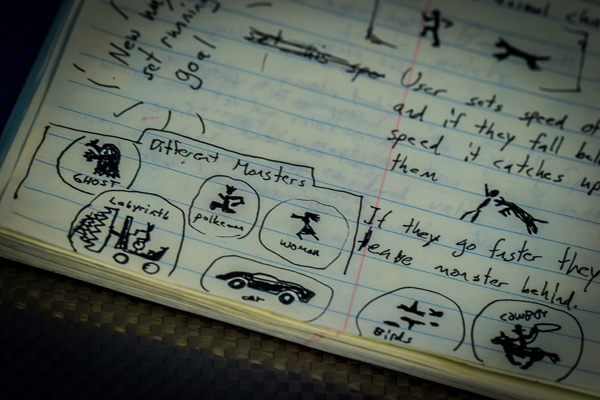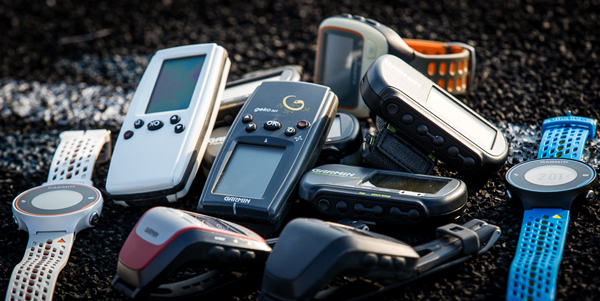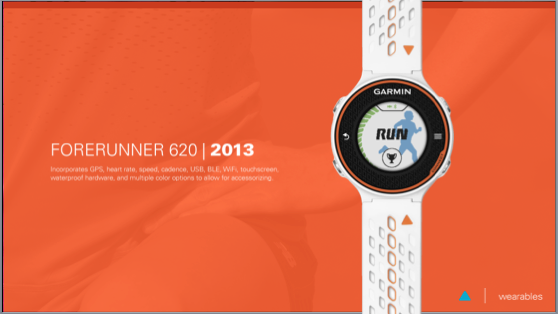Peg’s Posts: Front runners in fitness

Garmin associates were recently given a history lesson detailing how a few engineers stumbled on an idea 12 years ago that changed the fitness industry and launched a new division for the company. The lesson came just days before one of those fitness pioneers gave a presentation at a national conference on wearable technology. Here’s how it all got started.
It’s 2002. The closest thing to wearable technology in the Garmin product lineup is an eTrex GPS lassoed to one’s neck by a lanyard. Our engineers shrunk that handheld, gave it a splash of color and released it into the wild under the name Geko. We hoped hikers and climbers would be eager to adopt this lighter, thinner trail guide.
“Geko never really took off,” said Claudette, a software engineer who’d worked on the team. “But during testing one day, we strapped it to our wrists and discovered it did a pretty good job tracking distance and speed.” How far and how fast. Those simple data points instantly struck a chord with this young engineer who’d spent much of her high school and college days rounding the oval track.
Under the guidance of a couple of engineering team leaders who saw promise in delivering GPS-derived pace and distance data to runners’ wrists, a lean team started their race.
“We shut off our phones, we shut off email, we didn’t talk to the outside world,” said David, industrial designer. “We had two weeks to develop designs worthy to present to management.”
With two engineers on software, one mechanical, one electrical and one on industrial design, those two weeks were not unlike a relay, marked with max efforts and swift hand-offs. Did the team have an idea of the potential payoff to this focused push?
“Absolutely,” Claudette said. “I remember thinking this could be a whole new division for Garmin. We just had to convince others.” Their proof of concept was enough to convince management to commit resources into development, and then the real work began. In August 2003, Garmin introduced Forerunner 201, the world’s first all-in-one GPS training device. Inside Garmin walls, the oval odometer + speedometer came to be known as “the toaster.”

One of the toaster’s game-changing features was Virtual Partner — a set of moving pixels in the form of two runners — one representing you, one as your goal pace. “We wanted Forerunner to be a tool to help runners maintain a set pace, but I didn’t know how to show it on the watch,” Claudette said. “During the design phase, I just drew a black rectangle.” John, the other software engineer on the team, started brainstorming.

“Monsters, birds, a cowboy…what would motivate the runner to keep his pace? We even had a little fun with what the screen could display when you didn’t meet your goal,” John said. Check out some of the designs that didn’t make it out the door.
 Additional Forerunner models soon followed, sought out by triathletes, early adopters and serious runners who wanted pace and distance data without being confined to a track or treadmill. Was it wearable technology?
Additional Forerunner models soon followed, sought out by triathletes, early adopters and serious runners who wanted pace and distance data without being confined to a track or treadmill. Was it wearable technology?
“I think so,” Claudette said. “In fact, I know there are still some runners wearing those legacy devices today. The GPS reception on the original Forerunners worked great as long as you were in open spaces. If you were in downtown New York City or on trails with lots of trees, not so much.”
So how long did it take for those original Forerunners to find satellites before you could take off?
“By today’s standards, it was a long time,” she said. “We would tell customers that satellite acquisition time was a feature that gave you a chance to stretch before you started your run.”
Soon, it was time for a new toaster. One that might solve some of the reception issues of the original models. “I remember asking engineering if we could move the GPS antenna 45 degrees so it would wrap around the runner’s wrist and point to the sky as they ran,” David said. “The answer was ‘we don’t know, but let’s try it.’”
And thus was born the Forerunner 205 and 305. By no means sleek, but by all measures better at delivering the stats runners craved. “The 205 and 305 were our first watches to use ANT+ technology to pair with heart rate and other sensors since there were no other low-power solutions on the market,” said Justin, who was electrical engineer on the team.
The next big leap came in 2008 with the Forerunner 405, the first Garmin wearable with a smaller, watch-like form factor. “In the concept phase for 405, we showed the engineers a bunch of nice watches and started asking ‘what if,’” David said. “What if you gave up 20% battery life and some screen size? Could you build this?”
“The goal was really to get it into a true watch form factor while not sacrificing GPS performance, which is a challenge when the entire product had to shrink significantly,” Justin said. “We sacrificed some battery life, but designed the 405 so it was still able to last with you during a marathon, even if you had to walk it. This, in addition to functioning as a watch for two weeks on a single charge, required a huge focus on power consumption and battery life.”

The “what ifs” have continued, with Garmin fitness devices getting smaller, smarter and able to connect with myriad sensors as well as your phone. They’ve spilled over into our vívofit activity trackers, with engineers asking “what if we can give it a one-year battery life so users don’t have to take it off?” As our lineup of wearables evolves, one can’t help but wonder what’s coming up next. That’s where this history lesson ends and the next round of “what ifs” begins.
The post Peg’s Posts: Front runners in fitness appeared first on Garmin Blog.
Sample Block Quote
Praesent vestibulum congue tellus at fringilla. Curabitur vitae semper sem, eu convallis est. Cras felis nunc commodo loremous convallis vitae interdum non nisl. Maecenas ac est sit amet augue pharetra convallis nec danos.
Sample Paragraph Text
Praesent vestibulum congue tellus at fringilla. Curabitur vitae semper sem, eu convallis est. Cras felis nunc commodo eu convallis vitae interdum non nisl. Maecenas ac est sit amet augue pharetra convallis nec danos dui.
Cras suscipit quam et turpis eleifend vitae malesuada magna congue. Damus id ullamcorper neque. Sed vitae mi a mi pretium aliquet ac sed elitos. Pellentesque nulla eros accumsan quis justo at tincidunt lobortis denimes loremous. Suspendisse vestibulum lectus in lectus volutpat, ut dapibus purus pulvinar. Vestibulum sit amet auctor ipsum.




